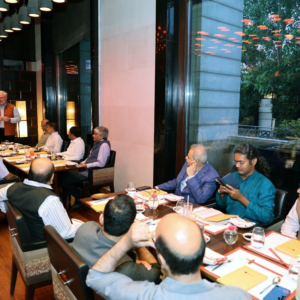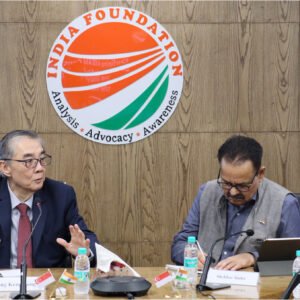The information age has truly empowered the individual to levels which were unimaginable even at the turn of the century, barely two decades ago. Today, even individuals at the lower end of the economic spectrum carry out digital financial transactions with consummate ease, converse in social groups such as FaceBook and WhatsApp and are reasonably well informed of current happenings in their immediate neighbourhood as well as on issues which impact the country. The digital revolution has also empowered people through schemes such as the ‘Jan Dhan Yojana,’ which has led to financial inclusion for millions of households who earlier had no access to banking facilities.[1] “Ayushman Bharat,” a flagship scheme of Government of India that was launched in 2017, is focussed on providing Universal Health Coverage (UHC) to the masses, with a commitment to “leave no one behind.”[2] Similarly, India’s Covid vaccine programme is based on digital technology, through the digital platform, ‘CO-WIN’. This user-friendly mobile app for recording vaccine data is working as a beneficiary management platform having various modules.[3]
The benefits of digitisation are immense especially in the field of governance. However, just as the smart phone and the internet have empowered the individual, the ubiquitous nature of information technology has also thrown up a range of opportunities for their misuse through disinformation, distortion of the truth, false flag operations, spoofing, spam mail, and the like, to create divisions and turmoil within society. The Information Environment (IE) is truly global in nature, with information flows cutting across physical and artificial boundaries and impacting all segments of society. This is both enabling as well as has potential for misuse. The wide range and diversity of actors in the global IE has great aggregate influence, much akin to that of a state and more often, even far in excess of what the modern state exercises. Non-state actors have also made their presence felt and seek to create influence in furtherance of their objectives. Towards this end, influencers are used, who unwittingly or otherwise lend their name to a social cause or movement, sometimes unknowing of the real intent of the provocateurs and at others, because of monetary inducement or being ideologically aligned to the cause. Non-state actors also use the media and exploit advances made in information communication technology to undermine governments and exert influence in furtherance of their aims.[4]
An example of the above is the efforts made by interested groups to undermine the BJP led NDA government ever since it won the Lok Sabha elections in 2014. A concerted campaign was launched by motivated groups in the months following the 2014 elections to showcase India as an intolerant nation. Here, an attempt was made to create religious discord by highlighting certain isolated incidences of vandalism that had taken places in churches as deliberate targeted attacks, when in fact they were nothing more than cases of petty theft, the likes of which were routine and had taken place in earlier years too. When viewed holistically with data analysis over the past ten years, there was no upward spiral of such cases, as alleged.[5] Such incidents had also happened with Hindu places of worship but that fact was glossed over. By the time the truth finally came out, India’s image stood tarnished, with even the then US President, Mr Barack Obama, who had come to India as the Chief Guest for the 2015 Republic Day Parade, making remarks on ‘religious intolerance’ and repeating the same on his return to Washington. The vicious attacks against India were motivated and designed to pressure India on its foreign policy and domestic policy options, with religious intolerance being used as a tool to make India conform to Western dictates.
The subsequent years saw protests on various issues, fanned by interested groups exploiting the social, audio-visual and print media. The year 2016 witnessed a series of agitations by student groups, who shouted slogans in support of a terrorist who was convicted for his role in the attack on India’s Parliament in 2001 and who was executed in 2013! The agitating students, supported by left wing and islamist groups, raised slogans seeking the break up of India and calling the act of execution of the convicted terrorist an act of murder. Similar agitations continued on various pretexts over the next two years. Then in 2019 there were huge protests against the Citizens Amendment Act (CAA) which brought parts of the nation’s capital to a standstill, peaking in February 2020, to tarnish the nation’s image when US President Donald Trump was visiting India.[6] And in September 2020, massive protests broke out against the three farm laws passed by Parliament, which peaked during the Republic Day celebrations in 2021. In all these protests there was a hidden agenda of undermining the elected Indian government, India’s democratic framework as well as India’s composite cultural ethos. Information was weaponised and used to draw crowds to disrupt normal life. This remains part of the agenda of external forces to exacerbate internal issues and fault lines. In this, segments of the opposition parties within India lend a helping hand in their bid to get back to power. In the end, it is the people of India who suffer.
The desire to shape opinions remains the key motivator for organising mass movements against the elected government. This suits the agenda of foreign powers who view India’s rise as a potential threat to their economic interests. It is therefore incumbent on the state to preempt hostile agendas by anticipating what disruptors might do and taking preventive action well in time. This can be done by shaping public perceptions through a long-term vision and with strategic patience.
A potential flashpoint is the current controversy created by the Muslim clergy wherein they seek an alteration to the rules with respect to wearing of school uniforms, so as to allow Muslim girls to wear the hijab. This is a clever ploy by the Muslim clergy to keep Muslim women under subjugation, by invoking their right to study and also invoking their constitutional right to religious freedom. The narrative being spun is that Muslim girls are being denied their right to wear the hijab. This is patently false as there are no restrictions on Muslim women to wear any dress they choose. The restriction is only in the classrooms where the children have to abide by the school dress code. Comparisons with a Sikh male child who wears a turban in class are frivolous as the hijab is not mandated by the Quran to be worn by women and is also not an essential religious practise. The larger danger in interfering with school dress code rules is that if the hijab is permitted, then the Muslim girl child will lose her right of choice, as the clergy will use the power of religious coercion to force her to wear the hijab as a necessary condition to be accepted in their society. This is retrograde and a push back to medievalism.
Another social media favourite of certain groups of people is targeting Diwali and other Hindu festivals. The former always comes up for attack on grounds of pollution, with claims that firecrackers pollute the air. What they fail to address is the poor air quality throughout the year, which has nothing to do with Diwali. Throughout the year, the air quality index (AQI) levels in Delhi and the NCR remain in the poor to very poor category. Diwali is celebrated only on one day and is not a contributory factor to the year long pollution, though the AQI levels do rise for a day after Diwali. Attacks on Diwali are thus motivated and designed to create communal friction. The pollution causing factors which should be addressed are construction activities and vehicular traffic which account for most of the pollution throughout the year. As a long-term measure, an efficient bus service within Delhi and the NCR can reduce the use of private vehicles by about 50 to 75 percent. For that, perhaps an additional five thousand buses need to be added to the existing fleet. This preferably should be run by the private sector and not the government. A long-term ban on new residential construction would also be useful on two counts. One, it would mitigate to a great extent, the particle pollutants that escape into the air. Two, it would halt the unchecked population growth in the NCR through migration, which is creating a severe strain on the existing infrastructure. Population control has also to be a part of the larger picture to control pollution levels as human beings are the only polluters in the planet. Suitable narratives which are gender neutral and religion and caste neutral need to be propagated to get wide acceptance from all segments of society and to change behaviour patterns. A proactive stance in shaping perceptions will go a long way in reducing friction and in addressing societal fault lines to prevent internal and external hostile forces from creating disruptions in society. This assumes importance as the spotlight will be on India for the coming year, when it takes on the Presidency of the G20 this December.
Author Brief Bio: Major General Dhruv C Katoch is Director, India Foundation and Editor, India Foundation Journal
References:
[1] https://pmjdy.gov.in
[2] https://nha.gov.in/PM-JAY
[3] https://www.pib.gov.in/PressReleasePage.aspx?PRID=1679181
[4] https://smallwarsjournal.com/jrnl/art/making-sense-information-environment
[5] https://indianexpress.com/article/india/india-others/false-church-attack-claims-to-humiliate-bjp-govt-says-vhp/
[6] https://timesofindia.indiatimes.com/india/us-president-donald-trump-in-delhi-key-points/articleshow/74296423.cms




